Can Turtles Survive In Cold Weather?
Turtles are known for their hardy nature and ability to survive in a variety of conditions. But when it comes to cold weather, can turtles really hold up? So, “can turtles survive in cold weather?”
Yes, turtles can survive in cold weather to some extent, but they must deal with many hurdles to thrive. And their survival depends on various factors such as species, location, water temperature, etc. Also, turtles develop several techniques to survive winter, like- forced hibernation, slowing down metabolism and energy demands, cloacal breathing, hiding inside the mud, and more.
In this blog post, we have briefly described how turtles survive the winter months. So, without delaying more, let’s get started.
Related article about turtles:
Can Turtles Survive In The Winter?
Indeed, turtles can survive in the winter through a phenomenal array of adaptations. These reptiles try to match their body temperature with their surroundings as they are ectotherms.
Not only that, but they can also drop their blood-oxygen level near to zero, in which condition we humans can survive for two to three minutes.

For instance, painted turtles are especially adept at handling the cold, and adults can survive in water as cold as 37 degrees Fahrenheit without food or oxygen for up to 100 days.
Besides that, turtles utilize their stored energy and cloacal breathing technique to survive in the winter. These reptiles draw oxygen from the water when it passes over the blood vessels in their skin, mouth, cloaca, or hind end.
How Cold Is Too Cold For Turtles?
Being ectothermic or cold-blooded species, turtles can’t yield body heat or sweat and rely on environmental temperature to thrive. Moreover, different species of turtles have different tolerance levels to cold temperatures, but in general, temperatures below 50°F (10°C) can be too cold for most turtles.
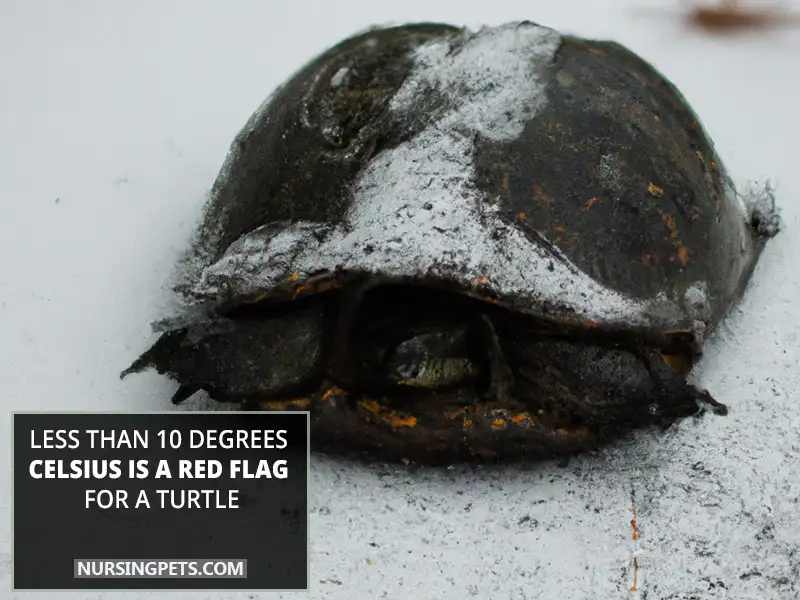
If they stay in such a cold place for a prolonged period, they will gradually become sluggish and stop moving and eating. Consequently, they will starve to death.
How Do Turtles Survive in Cold Weather?
Turtles are adaptive and hardy creatures. And here are some key ways that turtles are able to survive in cold temperatures:
Metabolism slowdown: During the winter months, the metabolism of most turtles slows down to conserve energy.
Cloacal respiration: Turtles can survive off cloacal respiration, which allows them to absorb oxygen through the skin around the cloaca instead of breathing through their lungs.
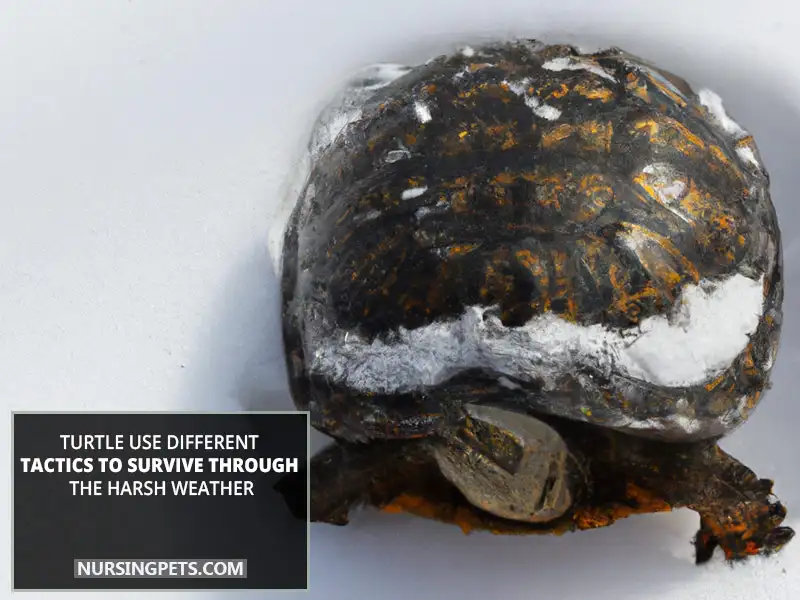
Brumation: Turtles engage in brumation, a period of dormancy similar to hibernation, during which they move to the bottom part of ponds or lakes to stay protected.
Calcium absorption: Some turtle species, like painted turtles, can use the calcium in their shells to balance their blood acidity and mitigate the effects of cold weather.
Adaptations: Different turtle species have different adaptations that allow them to survive in cold weather. For example, Snapping turtles and Painted turtles are also able to survive for over 100 days in cold water temperatures in the lab.
But remember that if the weather temperature goes below the freezing point, the turtle may freeze to death.
How Do Turtles Survive A Winter Underwater?
Various turtles apply different strategies to survive cold days. They adapt according to their surroundings and environment. Some reptiles, such as freshwater turtles, entomb themselves to the muddy bottom of the ponds and slow down their metabolism.

These activities allow turtles to survive for a prolonged period without food and with very little oxygen, also known as hibernation or brumation. But “how long turtles live in cold water?” or “how long can turtles survive in cold water?” differs from species to species.
For example, if you wonder, “how long can red-eared sliders live in cold water?” here you go: these reptiles can stay active in such an environment for three to four weeks. On the contrary, adult painted turtles can survive for up to 100 days without food and in extreme cold.
However, alongside hiding inside the mud and utilizing stored fat, turtles use a specialized breathing technique to survive. Basically, it’s more like exchanging gas than breathing. We will disclose more information about how they breathe in cold water later in this content.
Hence, these are some significant winter survival techniques turtles follow to thrive. But there are more, which we have described in the following question-answer section.
How Do Turtles Breathe Underwater In The Winter?
Turtles breathe through their nares when on land, but their respiration method changes drastically when underwater, especially during the winter.
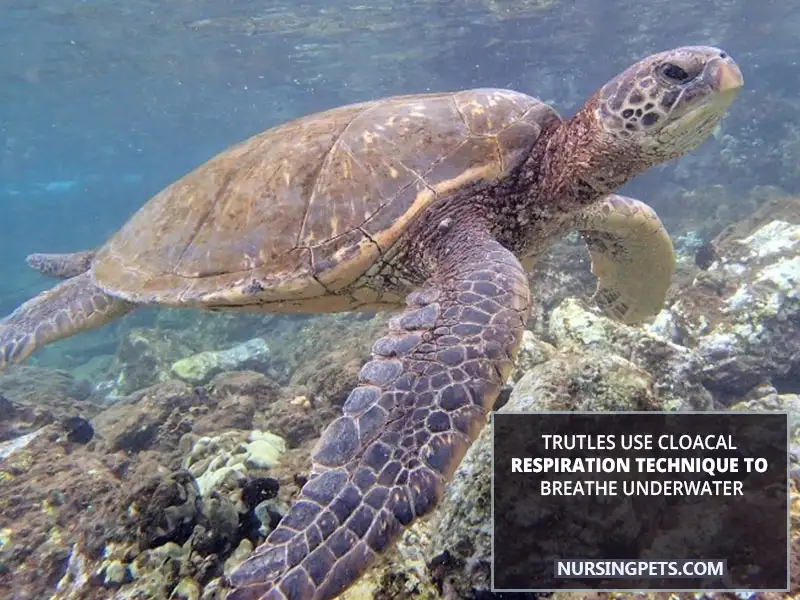
At this time, turtles initiate the cloacal respiration technique to breathe underwater in the winter. They diffuse oxygen into their body and carbon dioxide out of the body with the help of their cloaca.
Also, these reptiles slow down their metabolism to reduce food and oxygen intake on cold days. This way, most turtles breathe and survive for several days in the winter.
How Do Baby Turtles Survive Cold Winters?
Although many baby turtles can’t survive the winter days, some make it. According to a phenomenon that many researchers believe that some turtle hatchlings, like the painted baby turtles, can produce anti-freeze compounds to deal with the winter.
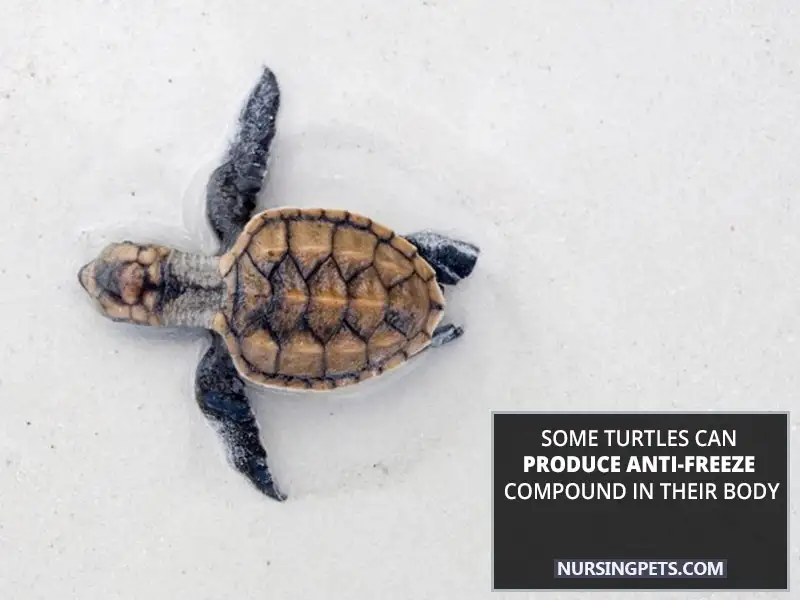
When exposed to freezing temperatures, they can yield a high level of glucose to protect themselves from extreme cold. Not only that, but they can also utilize their reserved fat to thrive even without eating.
Another mesmerizing fact about baby turtles is that some can survive even when half of their internal body water freezes; what a miracle it is!
How Do Snapping Turtles Survive Winter?
When other turtle species slow down their metabolism while under nearly frozen water, snapping turtles don’t, rather, these reptiles shift their metabolism to avoid using oxygen and to survive in the winter.
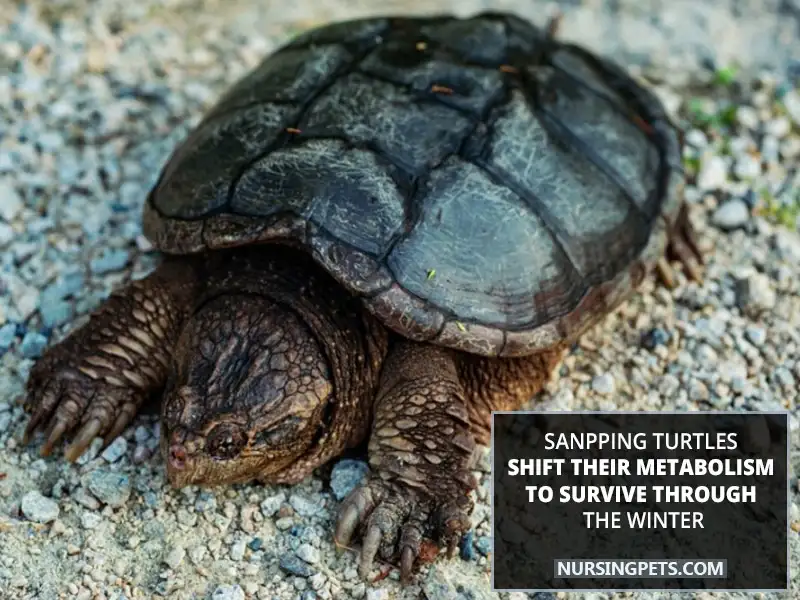
By shifting metabolism, snapping turtles produce acidic toxins in their body, neutralizing them by dissolving calcium in their shells like a built-in antacid.
We have covered three interesting blogs about snapping turtles. If you want, you can check them here:
Snapping turtles can stay in such uncomfortable conditions for up to 100 days, and in this way, they survive the winter months. But do snapping turtles hibernate?
It appears that while snapping turtles are known to hibernate in the wild, the extent to which they hibernate may vary depending on their location and the severity of the winter climate.
Some sources suggest that snapping turtles will only hibernate if the temperature drops enough, while others indicate that snapping turtles may simply remain dormant during less harsh winters.
How Do Sea Turtles Survive The Winter?
Sea turtles can’t regulate their body temperature during the winter like other reptiles. Thus, they seek out warm places when the temperature goes below 50 degrees Fahrenheit.

They search for comfy locations by swimming away from shore to deep water or migrating to different areas. However, they will be cold-stunned if they fail to find a warm place to thrive.
In this condition, they become lethargic and can’t swim, causing them to float at the water’s surface. If they remain in this condition for an extended duration, they can develop severe health problems and may die eventually.
Do Turtles Hibernate In The Winter?
People have misconceptions concerning the turtle’s hibernation. Some believe these reptiles hibernate during the winter to survive, while others deny this phenomenon.

So, what’s the reality? Well, turtles don’t hibernate, but they brumate. Brumation is a condition where turtles slow down their metabolism, utilize stored energy, and remain inactive, sluggish, and in a torpor state for a prolonged period.
However, in the following question-answer sections, we have answered some other hibernation-related queries about turtles. Let’s read them.
Do Turtles Hibernate Underwater?
As you already know, turtles don’t hibernate. Instead of that, they brumate. So, if you ask, “do turtles brumate under water?” the answer is yes.
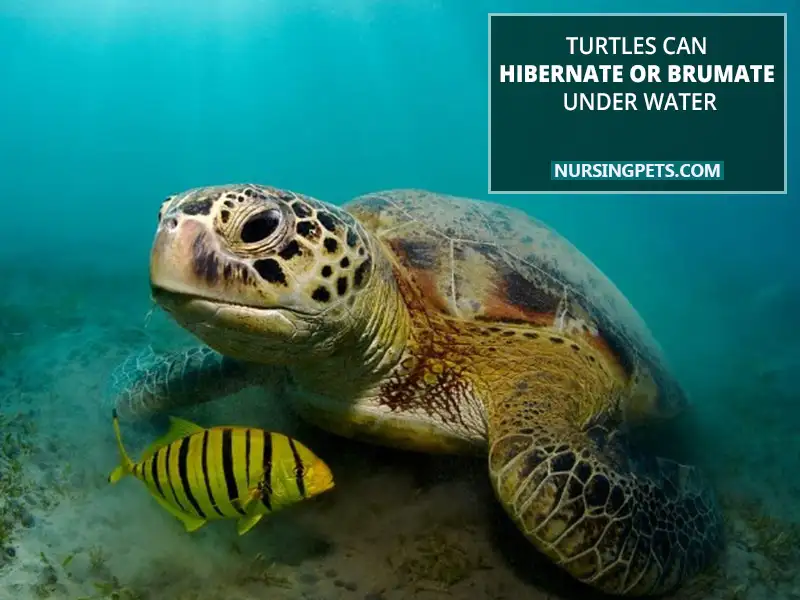
And if you wonder, “how long do turtles hibernate?” the answer is they can remain underwater for several hours while sleeping. FYI, turtles can hold their breath in cold water for up to seven hours.
Do Box Turtles Hibernate In The Winter?
Like other turtle species, box turtles don’t hibernate. They brumate, however, and can remain inactive for several days during the winter months.

Basically, these reptiles burrow themselves inside the soil and go into a torpor state to deal with the cold days. So, if you think about” where do box turtles go in the winter?” there you have your answer.
So, these are all the answers related to turtles’ hibernation during the winter.
Can Turtles Live In A Pond During Winter?
Despite facing a lot of hurdles, turtles can live in a pond during the winter. Turtles submerge in pond water and swim below the pond’s frost line to avoid freezing temperatures.

Occasionally, turtles can emerge from the pond water in search of food and oxygen, but mostly, they remain underwater until spring. However, if the pond water becomes frozen, adult turtles may not survive.
Turtles can’t live for long with ice crystals in their bodies. That stated, if you were looking for the answer to the question, “can turtles survive in a frozen pond?” we hope you get it.
How Can You Help A Turtle Survive In Cold Weather?
There is literally nothing you can do for the outdoor turtles to help them survive the winter easily. Those reptiles will survive independently by submerging deep into the water or entering the pond’s soil.
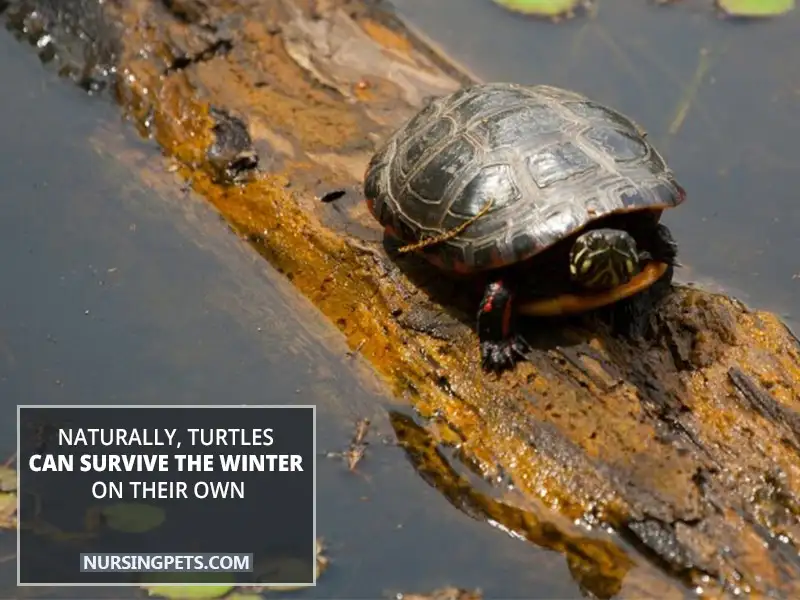
Besides, they will slow down their metabolism and change their breathing mechanism. However, you have a plethora of duties to perform if you want to help indoor turtles survive in cold weather. Let’s get started:
How Do I Keep My Turtles Warm In The Winter?
First of all, feed them well at the beginning of winter. Otherwise, turtles won’t build up the fat they need to survive those cold days. Secondly, make your turtle tank habitable and winter-friendly for those reptiles.
To do that, you can install the best-quality heating lamp above the basking area and ensure the light can keep the basking area’s temperature to 92 degrees Fahrenheit. And if you’re looking for one right now, check this product on amazon.

Check Product Details (Amazon)
Last but not least, to keep the tank water at optimal temperature, you can utilize an aquatic reptile heater to keep the water temperature at 70 to 85 degrees Fahrenheit. Consequently, if you’re searching for one, check out this turtle heater.
So, these are some significant steps you can follow if you wonder, “How can I keep my turtles warm at night?”
What Do I Do With My Turtle In The Winter?
Depending on the turtle species, you can keep them indoors or outdoors. For instance, terrestrial and semi-aquatic turtles can match winter outdoor temperatures and survive as long as the environment remains safe.
However, these reptiles will face fewer challenges if they get a comfy indoor environment during the winter. Although adult turtles can survive the challenging winter months, baby turtles can barely make it.

Check Product Details (Amazon)
So, if you have some turtle hatchlings, you should build a winter enclosure for them to survive. And to accomplish this job, you should install a water heater, basking dock, UV bulb, and heating light (All these links will take you to amazon). You may do the same for adult turtles to lessen their winter sufferings.
Frequently Asked Questions:
Can Turtles Die From Being Too Cold?
Although turtles can survive the winter months, some face extreme difficulties at this time, especially when the temperature goes below 50 degrees Fahrenheit. In extreme conditions, turtles can die from being too cold.
Where Do Turtles Go When The Water Freezes?
Most turtles dive deep into the water and bury themselves in the mud. They brumate at this time and wait for spring to come out of the soil.
Final Words:
Turtles can easily deal with a cold environment if the temperature remains tolerable. Most turtles fight the cold by brumating while entombed inside the mud. But if the temperature gets too low, these reptiles may die.
We hope now you have extensive knowledge of whether turtles can survive in cold weather or not. If you truly do, you may share this blog post in appreciation with your family and friends via Facebook, Twitter & Pinterest.
Image Source: Canva.com/photos
Reference Website Source:
- Carleton.edu/arboretum/news/how-do-turtles-survive-the-winter-2/
- Portercountyparks.org/blog/where-do-turtles-go-in-the-winter
- Pbsnc.org/blogs/science/its-brumation-time-for-our-favorite-turtle/
- Petkeen.com/how-do-turtles-breathe/
- Dailyillini.com/life_and_culture-stories/2022/03/22/turtles-winter/

